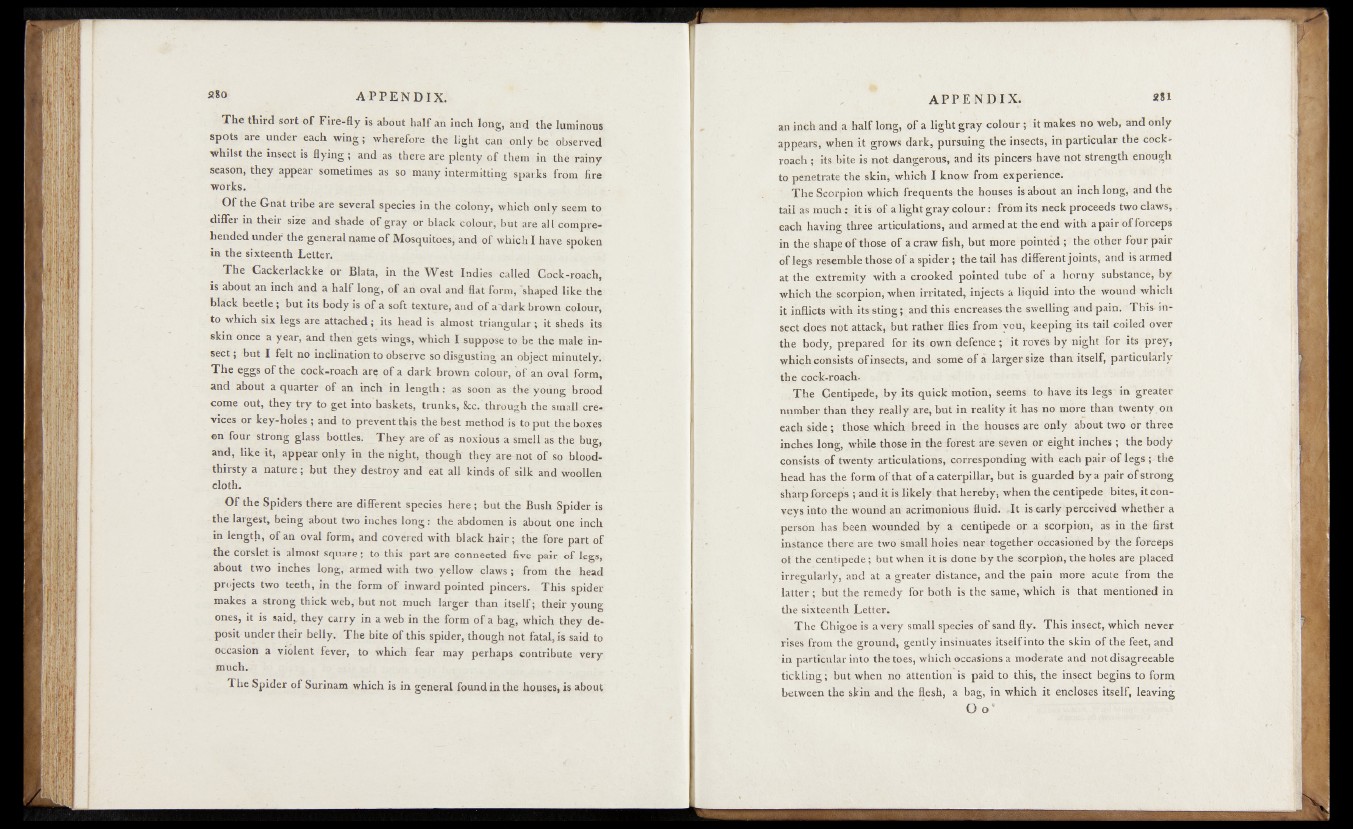
The third sort o f Fire-fly is about half an inch long, and' the luminous
spots are under each w in g ; wherefore the light can only, be' observed:
whilst the insect is flying ; and as there are plenty of them in the rainy
season* they appear sometimes as so many intermitting sparks from fire
works.
Of the Gnat tribe are several species in the colony, Which only seem to
differ in their size and shade of gray or black colour, but are all comprehended
under the general name o f Mosquitoes, and of which I have spoken
in the sixteenth Letter.
The Gackerlackke or Blata, in the West Indies called Cock-roach,
is about an inch and a half long, of an oval and flat form, shaped like the
black beetle ; but its body is o fa soft texture, and of a'dark brown colour,
to which six legs ate attached; its head is almost triangular; it sheds its
skin once a year, and then gets wings, which I suppose to be the male insect
; but I felt no inclination to observe so disgusting-an object minutely.
The eggs of the cock-roach are o f a dark brown colour, of an oval form,
and about a quarter of an inch in length: as soon as the young brood
come out, they try to get into'baskets, trunks, See. through the small ere-,
vices or key-holes; and to prevent this the best method is to put the boxes
en four strong glass bottles. They are of as noxious a smell'as the bug,
and, like it, appear only in-the night, though they are not of so bloodthirsty
a nature; but they destroy and eat all kinds of silk and Woollen
cloth.
Of the Spiders there are different species here; but the Bush Spider is
the largest, being about two inches long : the abdomen is about one inch
in length, o f an oval form, and covered with black hair; the fore part of
the corslet is almost square ; to this part are connected five pair of legs,
about two inches long, armed with two yellow claws; from the head
projects two teeth, in the form of inward pointed pincers. This spider
makes a strong thick web, but not much larger than itself; their young
ones, it is said,, they carry in a web in the form of a bag, which they deposit
under their belly. The bite of this, spider, though not fatal, is said to
pccasion a violent fever, to which fear may perhaps contribute very
much.
The Spider of Surinam which is in general found in the houses, is about
an inch and a half long, of a light gray colour ;• it makes no web, and only
appears, when it grows dark, pursuing the inseGts, in particular the cockroach
; its bite is not dangerous, and its pincers have not strength enough
to penetrate the skin, which I knqw from experience.
' The Scorpion which frequents the houses is about an inch long, and the
tail as much ^ it is o f a light gray colour: from its neck proceeds two claws,
each having three articulations, and armed at the end with a pair of forceps
in the shape o f those of a craw fish, but more pointed ; * the other four pair
of legs resemble those o f a spider; the tail has different joints, and is armed
at the extremity with a crooked pointed tube jff a horny substance, by
which the scorpion, when irritated, injects « liquid into the wound which
ijt inflicts with its sting ;v and this encreases the swelling and pain. 'This- insect
does not attack, but rather flies from you,- keeping its tail coiled over
the body, prepared for its, own d e f e n c e i t iroves by n igh t Tor its prey,
which consists of insects, and some of a larger size than itself, particularly
the cock-roach-
The Centipede, by its quick motion,, seems to have its legs' in greater
number than they really are, but in reality it has no more than twenty , on
each side ; those which breed in the houses are only about two or three
inches long, while those in the forest arevseven or e igh t iBches ; the body
I
consists of twenty articulations, corresponding with each pair of legs ;- the
head has the form of that of a caterpillar, but .is guarded by a pair of strong
sharp forceps ; and it is likely that hereby, when the centipede bites, it conveys
into the wound an acrimonious fluid. ^It is earityperceived whether a
person has been , wounded, by a centipede or. a scorpion» as in the’ first
instance there aye two small holes near togethermbcaskmed:by the forceps
of the centipede; but when it is done by the ;scorpiop, the holes are place'd
irregularly, and at a greater distance, and the pain more acute; from the
latter ; but,the remedy for both is, the same, Which is that mentioned in
the sixteenth Letter.
The Chigoe is a very small species o f sand fly. This insect;-which never
rises from the ground, gently insinuates itself into the skin of the feet, and
in particular into the toes, which occasions a moderate and not disagreeable
tickling ; but when no attention is paid to this, the insect begins to form
between the skin and the flesh, a bag, in which it encloses itself, leaving I ' o m